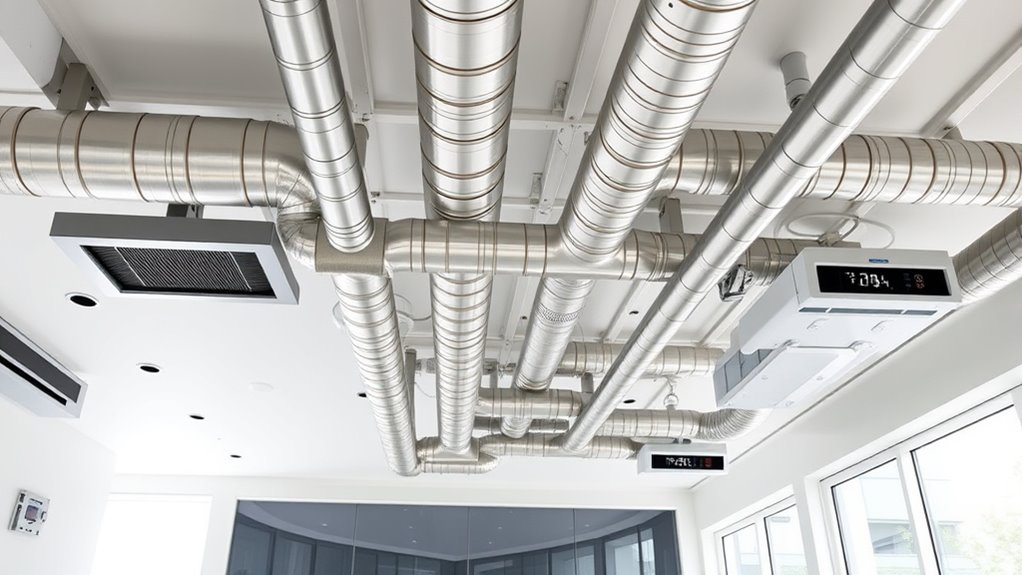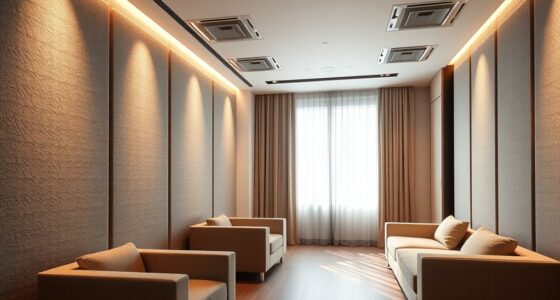To maintain a healthy indoor environment, guarantee proper ventilation by regularly exchanging stale air with fresh outdoor air through vents, windows, or fans. Controlling humidity is equally important; keep moisture levels between 40-60% using exhaust fans and dehumidifiers to prevent mold, condensation, and unpleasant odors. Monitoring humidity and maintaining your ventilation system helps protect your space year-round. Discover more ways to optimize your indoor air quality and stay comfortable and safe throughout the seasons.
Key Takeaways
- Ensure continuous air exchange using vents, fans, or windows to prevent indoor air stagnation and improve air quality.
- Maintain indoor humidity levels between 40-60% to prevent mold growth and moisture-related issues.
- Use exhaust fans in bathrooms and kitchens to vent excess moisture outside effectively.
- Regularly monitor humidity with hygrometers and perform maintenance on ventilation systems for optimal performance.
- Balance natural and mechanical ventilation strategies according to seasonal conditions to sustain healthy indoor environments.

Effective ventilation and humidity control are essential for maintaining a healthy and comfortable indoor environment. When you prioritize proper air exchange, you ensure that fresh air continuously replaces stale indoor air, reducing the buildup of indoor pollutants and allergens. This process not only improves air quality but also helps control moisture levels, which is crucial in preventing mold and mildew growth. Proper air exchange involves bringing in outdoor air through vents, windows, or mechanical systems like fans and ventilation units. By doing so, you remove excess indoor humidity and reduce airborne contaminants, creating a more pleasant and healthier space for you and your family.
Prioritize proper air exchange to improve air quality and prevent mold growth indoors.
Moisture removal plays a vital role in maintaining indoor comfort. When humidity levels are too high, you may notice a damp smell, condensation on windows, or even peeling paint. Excess moisture can foster mold growth, which can lead to respiratory issues and allergic reactions. To effectively remove moisture, you need to balance ventilation with dehumidification strategies. Using exhaust fans in bathrooms and kitchens helps vent humid air outside, especially during and after activities like showering or cooking. Additionally, employing dehumidifiers can help maintain optimal humidity levels, typically between 40-60%. This balance prevents the air from becoming too dry or too damp, both of which can cause discomfort and health problems.
You should also pay attention to how your ventilation system operates in different seasons. In colder months, you might hesitate to open windows due to heat loss, but ensuring adequate air exchange is still important to prevent indoor air stagnation. In warmer months, natural ventilation through windows or attic vents can be effective, but mechanical systems may be necessary if outdoor air quality is poor or if the climate is humid. Regular maintenance of ventilation components, like cleaning filters and checking for blockages, guarantees they function efficiently for moisture removal and air exchange. Additionally, understanding ventilation effectiveness can help optimize system performance and indoor air quality.
Monitoring indoor humidity with a hygrometer helps you decide when to increase ventilation or activate dehumidifiers. Remember, the goal is to keep humidity levels comfortable and safe, not just to ensure air exchange. Proper ventilation and moisture removal work together to prevent problems like condensation, mold, and indoor air pollution. By maintaining a consistent flow of fresh air and controlling moisture, you create a healthier environment that feels better and reduces the risk of health issues related to poor air quality. Ultimately, your awareness and proactive management of ventilation and humidity are key to sustaining a safe, comfortable, and energy-efficient indoor space.
Frequently Asked Questions
How Often Should Ventilation Systems Be Inspected and Maintained?
You should inspect and maintain your ventilation system at least twice a year to guarantee ideal filtration efficiency and airflow. Regular checks help identify dust buildup, worn filters, or blockages that can reduce performance. By cleaning or replacing filters promptly and optimizing airflow, you keep indoor air quality high and system efficiency maximized. Don’t forget to schedule professional maintenance annually for thorough inspection and to address any emerging issues proactively.
What Are the Best Methods to Measure Indoor Humidity Accurately?
You can measure indoor humidity accurately using a well-calibrated hygrometer or dew point measurement device. Some people worry about calibration issues, but regular hygrometer calibration ensures precise readings. Dew point measurement offers a reliable alternative, especially in fluctuating conditions. To get the best results, keep your instruments in good condition, follow manufacturer instructions, and check calibration periodically, guaranteeing you maintain ideal indoor humidity levels effortlessly.
How Does Outdoor Climate Influence Indoor Ventilation Strategies?
You should adapt your indoor ventilation strategies to the outdoor climate by considering climate adaptation and outdoor airflow. When it’s hot or humid outside, increase ventilation to reduce indoor moisture and temperature. In colder weather, minimize outdoor airflow to conserve heat while maintaining air quality. Adjusting your system based on outdoor conditions helps balance indoor comfort and energy efficiency, ensuring ideal indoor air quality regardless of external climate changes.
Can Humidifiers and Dehumidifiers Operate Simultaneously?
Sure, you can run a humidifier dehumidifier simultaneously—if you’re aiming for chaos. In reality, these devices are designed to counteract each other. Their simultaneous operation is usually unnecessary and can even damage your equipment. Instead, pick the right device based on your indoor humidity needs. If you want balanced air, set your humidifier dehumidifier to work in tandem carefully, or better yet, let one do the job at a time.
What Are the Health Risks of Poor Ventilation and Humidity Control?
Poor ventilation and humidity control can seriously impact your health. You risk exposure to airborne pathogens that thrive in stagnant air, increasing your chances of respiratory infections. Excess humidity promotes mold growth, which can trigger allergies and asthma. Without proper airflow and moisture balance, your indoor environment becomes unhealthy, leading to discomfort, illness, and long-term health issues. Addressing ventilation and humidity is essential for maintaining a safe, healthy living space.
Conclusion
By mastering ventilation and humidity control, you keep your indoor space comfortable and safe—no need to be a knight in shining armor, just a savvy homeowner. Think of it as your secret weapon against mold and stale air, ensuring freshness every day. Don’t forget, like a trusty steed, proper airflow and humidity balance are your best allies in this fight. Stay vigilant, and your home will be a haven, not a castle under siege.









